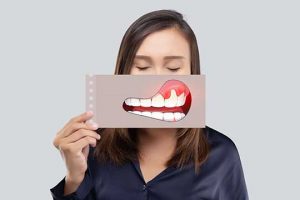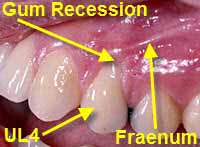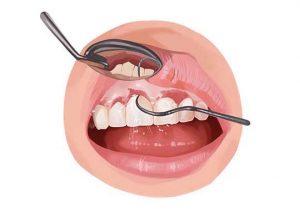Table of Contents
Gum Recession Overview
The gum of your teeth can gradually pull away and expose the root of the teeth. Gum recession can be dangerous as it makes your teeth root prone to infection.
Gum recession is a common dental condition. The occurrence of gum recession increases with age.
According to a study, gum recession occurs in 38% of individuals between 30-40 years.
It occurs in 71% of individuals between the age of 50-60 years. And the percentage is most high among the age group of 80-90 years. So the occurrence of receding gums is about 90% here.
Gum recession can lead to tooth decay, infection and loss.
Early diagnosis and treatment are important for receding gums. If people start early treatment, then without surgery, the gum recession can be reverted.
Gum recession shows some common dental symptoms such as pain, sensitivity, bleeding, etc.
The treatment methods include teeth cleaning, medications, gum graft surgery.
Though it’s a very common dental condition, people very often come late to the doctor and cannot be treated without surgery.
Let us dive deep into gum recession.
What Are Gums?
The gums are the pink tissue that covered the root of the teeth. The gums are also known as gingiva. There is one gingiva for each set of teeth.
Gum tissues are dense and soft, with a good blood supply. Blood vessels are underlying beneath the mucus membrane or soft outer layer.
Gum tissues are connected to the rest of the mouth.
The gum is connected firmly with the jawbone and covered the root of the teeth.
The principal function of the gums is to protect the teeth.
Gum recession is characterized by gradually pulling out of the gum tissues. It exposes the root of the teeth. The teeth can easily be infected if receding gum is present.
Teeth decay and infection are the most common complications of gum recession.

Functions of The Gums
Gum health is important. It protects the teeth. Weak or infected gum is a threat to the health of the teeth.
The functions of gum include;
- Gum physically prevents infection, blow or tooth decay.
- The soft tissues of the gum protect the underlying bones.
- Healthy gum prevent food particle lodging in the gap of teeth
- The gum tissues are soft, and moisture that is important for teeth health.
Symptoms of Gum Recession
Most of the dental complications show some common symptoms. But, unfortunately, most people ignore the symptoms and cannot get the early treatment of gum recession.
Symptoms of receding gum include;
- Teeth appear longer, and the space between teeth increases.
- Pain in the gum
- Bleeding
- Signs of infection
- Bad breath
- Swollen the surrounding gums
- The roots of the teeth are visible sometimes
- Cold and heat sensitivity
- Teeth decay and lose teeth
The early symptoms may include sensitivity, dental pain, visible gum recession.
One should not ignore any signs of gum recession. However, early treatment can be done without any surgery.
Everyone should visit the dentist twice every year for dental prophylaxis. During dental prophylaxis, the dentist cleans your oral cavity and makes sure everything is fine.
Causes of Gum Recession
Poor oral hygiene is the principal cause of gum recession. However, people who maintain proper oral hygiene can also experience gum recession.
Physical damage in the gum, bacterial inflammation cause gradual pull away of the gum tissues.
The receding gums can also occur because of genetic factors such as positioning the teeth and gum thickness.
Brushing harshly can cause receding gum. Gums are soft tissues. Brushing with care is necessary. Eating hard foods can also damage your gums and lead to receding gums.
Over-brushing should always be avoided.
Gum recession occurs more in the left side of the mouth because 90% of the people are right-handed, putting more pressure on the left side while brushing.

Tooth extraction can lead to gum recession sometimes.
Tooth piercing is very dangerous and can lead to gum recession. Therefore, you should consult a dentist before and after a tooth piercing.
Lip and tongue piercing can also lead to receding gum.
Those who are immunocompromised, have an existing dental condition, do not maintain proper oral hygiene should be strongly prohibited from any kind of piercing.
Thinner gums are more likely to be experienced recession than thicker gum.
Bruxism or tooth grinding can also lead to gum recession.
Some other causes of gum recession may include;
- Dental plaque
- Inflammed gums (medically termed as gingivitis)
- Periodontitis may lead to gum recession. This condition creates space between the teeth; loss of connective tissue fiber and bones around the teeth root can recede gums.
Periodontitis is one of the major underlying conditions that lead to receding gums. It causes loss of the supporting bone and connective tissues surrounding the teeth.
Gum recession can affect the gums of multiple teeth. In addition, it increases the risk of teeth decay.
Risk Factors Of Receding Gums
There are some risk factors of gum recession that may include;
- Age (older people are more affected by gum recession)
- Poor oral hygiene
- Smoking and tobacco chewing
- Genetical factors
- Immunocompromised person
- Diabetes mellitus
Age and poor oral hygiene are the most common factors of receding gums. Therefore, maintain proper oral hygiene to prevent such conditions.

Gum Recession Treatment
The early stage of gum recession doesn’t need special treatment. However, your dentist may give you some advice about oral hygiene.
Your dentist may also provide you instructions on using antimicrobial mouth wash, proper brushing technique, etc.
Some people with gum recession need treatment. Their treatment methods may include;
- Dentin bonding agents and burnishes – These agents enhance the healing process and help to bind the soft tissues with the root of teeth. The Burnishes provide additional protection against infections.
- Desensitizing agents – They reduce the sensitivity of the exposed teeth root. You can brush your affected teeth and gum without extreme sensation. That helps you to keep your gum and teeth clean.
- Composite restoration – The dentist put a tooth-colored mixture (resins) to the exposed root in this technique. It prevents microbial colonization and protects the exposed root.
Composite restoration technique is also used to hide the black gaps between the teeth.
- Pink composite – It is used to put a coating over the site of receding gums. This composite is the same color as gums, so it looks natural.
- Removeable gum veneers are made of silicone and used to replace a large area of gum recession.
- Orthodontics procedures – This procedure is used to change the position of the teeth. If the gum recession is occurred due to the position of the teeth, then it’s done.
It’s a slow process and takes multiple visits to your dentist.
Gum Recession Surgery
Gum recession surgery is clinically known as gum graft surgery. In this procedure, the surgeon collects tissues from the roof of your mouth (palate) and places them at the site of gum recession.
Treatment of gum recession is not so complicated, but you have to maintain your oral hygiene properly.
Yearly, two visits to your dentist for dental prophylaxis are mandatory.

Prevention Strategy
Poor oral hygiene, smoking, and poor eating habits are major causes of gum recession; it’s preventable.
The prevention strategy of receding gum may include;
- Brush your teeth twice a day, 12 hours apart. Do not use heavy strokes to brush your teeth. Gently brush, and make sure you are using the proper technique.
- Use soft toothbrush
- Floss your teeth regularly, and do not let any food particle lodged between your teeth
- Use antibacterial mouthwash if the doctor recommended
- Avoid eating so hard foods.
- If you experience bad breath or signs of infection, talk to your doctor.
Maintain proper oral hygiene. If you notice anything unusual inside your oral cavity, talk to your doctor.
If any signs of bleeding or infection are present, consult a doctor right away.
Visit a dentist once every six months for dental prophylaxis. It’s a preventive procedure. In this procedure, the doctor checks your oral cavity and makes sure everything is fine.
Read why does mouthwash burn?
Gum Recession Summery
Gum recession is a common dental issue. About 80% of people experience receding gums at any stage of their lifetime.
Poor oral hygiene, hormonal imbalance, faulty brushing techniques can lead to gum recession.
Prevention is the key here. Maintaining proper oral health can prevent it.
Early treatment doesn’t require surgery or almost any treatment. Some medications or just antibacterial medications work fine.
If the condition is severe, then you may need to undergo gum graft surgery.
Frequently Asked Questions (FAQs)
How to stop gum recession?
Consult with your dentist as soon as possible. The doctor may prescribe you some antibacterial medication and instruct you on how to enhance the healing of your condition.
What causes gum recession?
Poor oral health, brushing harshly, tooth extraction is the principal causes of gum recession. There are some other causes as well.
How to reverse gum recession?
Early gingivitis can be reverted without any surgery and medication. The doctor may clean your oral cavity with an antibacterial substance and provide you some instructions to follow.
How to treat gum recession?
There are multiple treatment methods available for treating gingivitis. Early gingivitis can be treated without any surgical procedure. If the condition is severe then you may need to undergo gum graft surgery.
Last Updated on February 23, 2022 by Learn From Doctor Team





